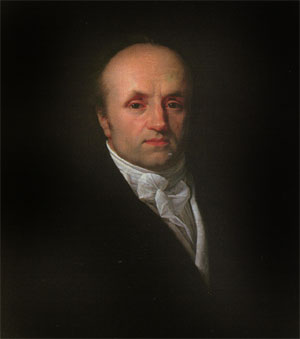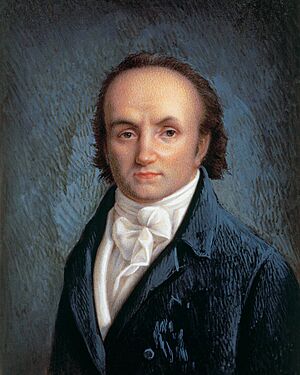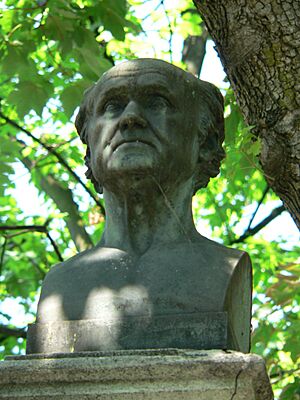Abraham-Louis Breguet facts for kids
Abraham-Louis Breguet (born January 10, 1747 – died September 17, 1823) was a brilliant horologist, which is a fancy word for someone who makes and studies clocks and watches. He was born in Neuchâtel, which was part of Prussia at the time. Breguet made many amazing inventions in watchmaking, including the famous tourbillon.
He also founded the Breguet company. Today, this company is known for its luxury watches and is part of the Swiss Swatch Group. During his lifetime, Breguet was seen as the best watchmaker around. Many important people and European royals were his customers. He is still considered one of the greatest watchmakers ever.
Contents
The Life of Abraham-Louis Breguet
Breguet's father passed away when he was only ten years old. He stopped formal schooling at age 12. His mother later married Joseph Tattet, who came from a family of watchmakers. Joseph Tattet had a shop in Paris.
In 1762, at age 15, Breguet began an apprenticeship with a master watchmaker in Versailles. He quickly showed great talent and intelligence. To learn even more, he took evening math classes. His teacher, Abbé Marie, became a good friend and helped Breguet meet King Louis XVI of France. The king loved mechanics and ordered many watches from Breguet, including a "perpetuelle" (a self-winding watch).
After finishing his apprenticeship, Breguet married Cécile Marie-Louise L'Huillier in 1775. Together, they started the Breguet watchmaking company in Paris.
Breguet's Amazing Inventions
Breguet invented or improved many parts of watches. These included special mechanisms called escapements, like the tourbillon. He also worked on automatic winding systems and improved the balance spring. Within ten years, rich families in France and even Queen Marie Antoinette were ordering watches from him. Sadly, Cécile passed away in 1780.
Around 1792, Breguet's fame grew. He became friends with Jean-Paul Marat, a leader during the French Revolution. Marat even helped Breguet escape to Switzerland and then England when Breguet was in danger. Breguet stayed in England for two years, working for King George III. When things calmed down in France, he returned to Paris.
Returning to Paris and New Ideas
In 1795, Breguet came back to Paris with many new ideas for watches and clocks. He reopened his business and quickly became popular among the new wealthy people. Instead of just hiring apprentices, he hired the best watchmakers in Paris to create his unique designs.
Around 1807, Breguet's son, Antoine-Louis, joined the business. The company then became known as Breguet et Fils (Breguet and Son). Breguet had sent his son to London to learn from a great English chronometer maker, John Arnold. Arnold, in turn, sent his son to learn from Breguet.
Breguet received many honors for his work. In 1814, he joined the Bureau des Longitudes, a group that worked on navigation. The next year, he became the official chronometer-maker for the French Navy. He also became a full member of the French Academy of Sciences in 1816. In 1819, he received the Légion d'honneur, a very important French award. Breguet's name is even one of the 72 names written on the Eiffel Tower.
Breguet was known for being kind and having a good sense of humor. He often encouraged his young apprentices, telling them, "Do not be discouraged, or allow failure to dishearten you." The business continued to grow. After Abraham-Louis Breguet died in 1823, his son and later his grandson continued the company.
Breguet's Famous Works and Influence
Breguet's company made about 17,000 timepieces during his lifetime. Because he paid such close attention to detail, no two Breguet pieces are exactly alike. Many famous people owned his watches, including King Louis XVI, Queen Marie Antoinette, Napoleon Bonaparte, and Alexander I of Russia.
The "Marie Antoinette" Watch
One of Breguet's most famous creations is the "Marie Antoinette" watch (No. 160). It is considered one of the most important and valuable timepieces ever made. Legend says Queen Marie Antoinette ordered it, but it was actually commissioned in 1783 by one of her guards, possibly as a gift for her.
This watch took almost 20 years to finish because work stopped during Breguet's exile. It was completed around 1802. The person who ordered it wanted every watch function and complication known at the time. They also wanted the most expensive materials, like gold, platinum, rubies, and sapphires, with no limit on time or cost. The watch cost a huge amount of money for its time – 30,000 francs!
Scientific Clocks and the Parramatta Observatory
Besides luxury watches, Breguet also made important scientific clocks. In 1818, a keen astronomer named Lieutenant-General Thomas Brisbane bought a Breguet clock. Brisbane brought the clock to Australia in 1821 for his observatory in Parramatta. The clock was so good that it was used for another 70 years! Today, this clock is part of the collection at the Powerhouse Museum in Sydney, Australia.
The Salomons Collection
Sir David Lionel Goldsmid-Stern-Salomons (1851–1925) was a British scientist and politician who loved clocks and watches. He became an expert on Breguet and his timepieces. He collected the world's largest private collection of Breguet watches, with 124 pieces. This included the "Marie Antoinette" watch.
In 1924, Salomons gave one of his watches, the "Duc de Praslin," to a museum in Paris. After Salomons died in 1925, his daughter Vera donated 57 of his best Breguet pieces, including the "Marie Antoinette" watch, to the L.A. Mayer Institute for Islamic Art in Jerusalem.
The Great Watch Theft
In 1983, the Mayer Institute was robbed, and 106 rare timepieces, including the entire Salomons collection, were stolen. The "Marie Antoinette" watch alone was worth millions of dollars. The case remained unsolved for a long time.
In 2006, the thief was identified as Namaan Diller, a well-known Israeli burglar. Before he died in 2004, Diller confessed to his wife. She tried to sell some of the stolen items back to the museum. Police later found more missing items in safes and storage units. By 2008, almost all the stolen items were recovered.
2011 Montre à Tact Discovery
In 2011, a special pocket watch was brought to the BBC TV show Antiques Roadshow. Experts identified it as an early Breguet montre à tact (a "tactile" or "touch" watch) from 1801.
This watch had a single arrow-shaped hand with small diamonds. The case was surrounded by twelve large diamonds. The back opened to show a smaller watch face with two hands. The watch was valued at at least £50,000, but similar watches have sold for much more. For example, a similar watch owned by Joséphine de Beauharnais, Napoleon's wife, sold for $1.3 million in 2007.
Breguet invented the montre à tact in 1799. These watches were not just for blind people, but for Breguet's richest clients. They allowed owners to tell the time without taking the watch out of their pocket, which was considered rude in social gatherings. Owners could also tell the time in the dark by feeling the position of the hand and the diamond markers.
Timeline of Breguet's Works
- 1775–1780: Improved the automatic winding mechanism for his "perpetual" watch.
- 1783: Invented the gong for repeater watches (before this, bells were used).
- 1783: Designed the famous "Breguet" hands, which are still used today.
- 1787: Improved the lever escapement, a key part of watch movements.
- 1790: Invented the 'pare-chute' anti-shock device to protect watches from drops.
- 1794: Invented a retrograde display mechanism, where a hand moves along a scale and then jumps back to the start.
- 1795: Invented the Breguet spiral, an improved balance spring.
- 1795: Invented the "Sympathique" clock, a master clock that could rewind and set a smaller pocket watch.
- 1799: Invented the montre à tact ("tactile") watch, which could be read by touch.
- 1801: Patented the tourbillon escapement, which he developed around 1795.
- 1802: Invented the echappement naturel, a special escapement that didn't need oil.
- 1821: Developed the "inking" chronograph, a stopwatch that could mark time on a dial.
Breguet was also known for making his watches look beautiful. In 2009, the Louvre museum in Paris had a big exhibition of Breguet's work. It showed many of his complex watches, including the "Marie Antoinette" replica and original tourbillons.
See Also
 In Spanish: Abraham Louis Breguet para niños
In Spanish: Abraham Louis Breguet para niños
- Breguet (watch)
- Horology
- Jean-Antoine Lépine





